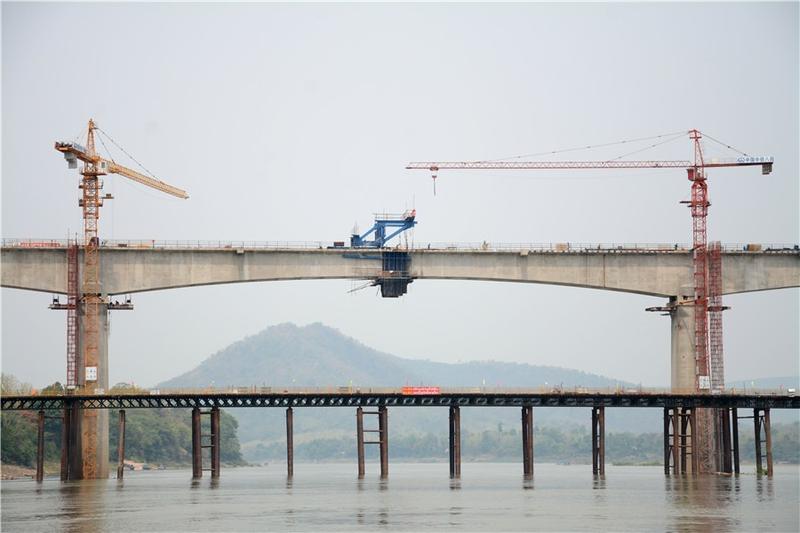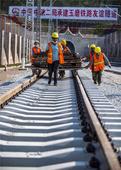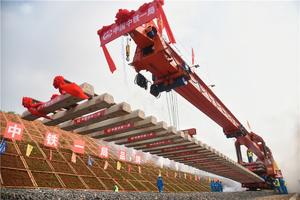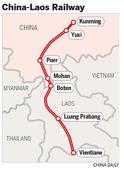Both countries to benefit from multibillion-dollar project
 The China-Laos railway crosses the Mekong River in Luang Prabang. (DUAN XIAOPING / XINHUA)
The China-Laos railway crosses the Mekong River in Luang Prabang. (DUAN XIAOPING / XINHUA)
Modern railways benefit a country's economy in many different ways. To name a few, they make it easier for bulky goods to be transported over long distances, reduce travel time between villages and cities and provide varying degrees of comfort for travelers.
For Benny Kong, 33, a hotel owner and co-founder of a tour company in Laos, a new rail line is poised to bring more domestic and international tourists to the country.
Kong, a Singaporean who lives in Laos, set up the MyLaoHome boutique hotel 14 years ago after a backpacking trip to Laos, during which he discovered there was demand for hotels in Luang Prabang, a former Laotian capital and a World Heritage Site listed by the United Nations Educational, Scientific and Cultural Organization.
"I visited the country when I was 18. I saw many tourists sleeping in temples and on the streets, so I just sensed the opportunity and then got started," he said.
Kong's business has grown in tandem with the tourism industry in Laos.
 A Lao New Year parade is held in Luang Prabang, Laos, in April 2019. (KAI QIAO / XINHUA)
A Lao New Year parade is held in Luang Prabang, Laos, in April 2019. (KAI QIAO / XINHUA)
MyLaoHome, launched in 2007 as a 12-bedroom guesthouse, now has more than 60 rooms and has benefited as more overseas visitors have traveled to Laos over the past decade.
Before the pandemic hit the world hard, tourist arrivals in Laos grew by 11.5 percent year-on-year in 2019, taking the country to 16th place on a list of the top 20 fastest-growing tourism destinations, according to the United Nations World Tourism Organization.
Nearly 757,000 Chinese visitors arrived in Laos in 2019, a rise of about 26 percent over the same period of the previous year.
Kong attributes growth in the tourism sector to improved infrastructure such as airports and roads.
In December, the first modern highway in Laos-constructed as part of the China-proposed Belt and Road Initiative-opened to traffic, linking the capital Vientiane and the tourist-oriented town of Vang Vieng.
However, for Kong, the highway is not enough. He is looking to the China-Laos railway, which is under construction and is expected to open at the end of this year.
 Visitors take photos in front of a temple in Luang Prabang in October. (KAI QIAO / XINHUA)
Visitors take photos in front of a temple in Luang Prabang in October. (KAI QIAO / XINHUA)
Operating speed
As part of the BRI, China and Laos began work on the rail project in December 2016. The line will link Kunming, capital of Yunnan province, and Vientiane.
With an operating speed of 160 km/h, the multi-billion dollar project will be built to Chinese rail standards.
A large part of Laotian territory comprises mountain ranges, highland areas and plateaus, with rivers winding their way through this terrain.
More than 60 percent of the new line consists of bridges and tunnels, which have posed technical difficulties during the construction work. The Laos-China Railway Co, a joint venture based in Vientiane, is responsible for building and operating the line, which is due to open in December.
Xiao Qianwen, general manager of the company, said the project is proceeding smoothly.
As of New Year's Eve, the main work had been completed, including 75 tunnels, 164 bridges and 180 road bed sections. More than 60 percent of the tracks had also been laid, Xiao told Xinhuanet.
The 1,022-km rail journey between Kunming and Vientiane is expected to take less than 10 hours, compared to a 30-hour bus journey, with the tourism industry in Laos standing to benefit greatly from the expected rise in rail passenger traffic.
Kong has prepared well for the new line, with his company converting an ancient building in Luang Prabang into a 58-room hotel.
He said he hoped the project would be completed by the end of this year, adding, "I would not have thought about expanding were it not for the BRI."
In 2019, Kong and his business partners launched discoverlaos.today, an online tour platform providing videos and pictures of the country's tourist destinations.
Going digital not only served him well when the tourist industry was badly hit by the pandemic, but it also could help attract more foreign visitors once border restrictions are lifted.
"The website runs three languages-Laotian, English and Thai-and we plan to launch our Chinese-language site by the end of this year," he said.
Kong added that he will also consider offering a China-Laos tour package after the new line opens.
"In the past, most foreign visitors came to Laos but did not visit China, because it was inconvenient. After the line starts operating, I can offer package tours in both countries," he said.
 A vendor sells fruit at the Lao Food Festival in Vientiane, the Laotian capital, in February. (KAI QIAO / XINHUA)
A vendor sells fruit at the Lao Food Festival in Vientiane, the Laotian capital, in February. (KAI QIAO / XINHUA)
Song Qingrun, an associate professor at Beijing Foreign Studies University's School of Asian Studies, said the line is expected to boost the local economy and improve people's livelihoods.
"For example, it will make life easier for people who live along the route, as transportation charges for commodities are expected to fall," Song said.
In a report released in June, the World Bank said that by linking with the vast BRI network, the China-Laos railway could potentially raise incomes in Laos by up to 21 percent in the long term.
The rail project has created thousands of jobs and generated additional economic activity in Laos, according to local media reports.
The project has also broadened the knowledge of those working on it.
After joining the Laos-China Railway Co as an intern in June, Dalavanh Sibounma, 25, started to learn about modern railway technologies. Since January, he has taken part in onsite training programs provided by the company.
He has learned a great deal, from laying tracks to checking and repairing locomotives, which he wants to drive when the line opens.
"I'm not sure if I can become a driver, but the experience I have gained from the project means a lot to me. I'm glad I have been able to learn about railway technologies step by step," he said.
The programs welcome not just employees engaged in the project, but also locals eager to seize the opportunity to learn new skills.
According to China Railway No 2 Engineering Group, which is involved in the project, more than 10,000 Laotian workers have benefited from the training.
Jia Duqiang, an associate researcher in Southeast Asian studies at the Chinese Academy of Social Sciences, said the new rail link will help trade between the two countries, taking it to a new stage.
"Transporting Laotian goods to China currently involves a long and arduous journey. They are first taken by truck from Vientiane to Kunming, which takes more than 30 hours. After being unloaded in Kunming, they are then taken by road to their destination cities across China," Jia said.
However, the high-speed line will shorten the journey time to half a day, he said, adding that, for example, passengers will be able to leave Vientiane in the evening and arrive in Kunming next morning.
Jia said the line will also speed up exchanges and increase cooperation between the two countries.
Sino-Laotian trade has grown rapidly in recent years, and China is now Laos' biggest foreign investor and the country's second-largest trading partner after Thailand.
 Workers carry out construction of the China-Laos railway. (JIANG WENYAO / XINHUA)
Workers carry out construction of the China-Laos railway. (JIANG WENYAO / XINHUA)
On the frontline
Yunnan, which borders Laos, has been on the frontline of exchanges between the two nations as well as other member countries of the Association of Southeast Asian Nations, or ASEAN.
From January to October 2019, investment between Laos and Yunnan reached 6.54 billion yuan, while cross-border trade rose by 32 percent year-on-year, according to Vientiane Times.
Despite the economic downturn triggered by the pandemic, Chinese investment in Laos reached US$1.16 billion in the first 10 months of last year, a year-on-year rise of more than 20 percent.
Before the pandemic emerged, trade between the two countries stood at US$3.92 billion in 2019, which Jia said was a big improvement, adding that there is still huge potential for expansion.
"If we compare this figure with those from other countries trading with China, it's not so big. There appears to be huge potential for China-Laos trade cooperation. The railway may help take bilateral trade to a higher level," he said.
Since December, China has implemented zero tariffs on 97 percent of goods imported from Laos.
Last year, China and ASEAN countries signed the Regional Comprehensive Economic Partnership, which is expected to boost mutual trade and investment, along with economic integration.
Song said the cross-border railway is also in line with the Laotian government's strategy of transforming the landlocked country into a land-linked economy.
With a population of more than 7 million, Laos is the only landlocked country in Southeast Asia, with the majority of people depending on agriculture-mainly growing rice.
Lying at the heart of the Indochinese Peninsula, Laos is bordered by Myanmar and China to the northwest, Vietnam to the east, Cambodia to the southeast and Thailand to the west and southwest.
Over time, being landlocked has been regarded as a disadvantage. Such countries are cut off from marine resources such as fishing, and more important, have no access to seaborne trade, which comprises a large proportion of international trade.
"Being landlocked, Laos has lacked the advantages of seaport logistics," Song said.
 Railway tracks are laid on the Yuxi-Mohan section of the China-Laos railway in Yunnan province in April last year. (LI MING / FOR CHINA DAILY)
Railway tracks are laid on the Yuxi-Mohan section of the China-Laos railway in Yunnan province in April last year. (LI MING / FOR CHINA DAILY)
The Laotian government has been determined to overcome the country's geographical limitations by promoting the concept that Laos acts as a land bridge, providing the most direct overland transportation routes between its coastal neighbors.
Laos also sees the BRI as an opportunity to build a modernized rail route to catch up with rapidly evolving global changes.
According to the World Bank report, the cross-border line could provide Laos with a link to global supply chains, making the country more attractive to investors.

"Transit trade through Laos along the railway corridor could reach an estimated 3.9 million tons per year by 2030, which would include a shift of an estimated 1.5 million tons of trade from maritime transport to the railway, " the report said.
"If Laos implements logistics and trade facilitation reforms, the railway could attract traffic currently using maritime and air routes. It could reduce land transport charges by 40 percent to 50 percent between Vientiane and Kunming, and by 32 percent between Kunming and the port of Laem Chabang in Thailand."
The new line is also an important section of the pan-Asia railway network, which in turn forms part of the Trans-Asian Railway, a wider plan drawn up in the 1960s with the aim of creating an integrated rail freight network across Europe and Asia.
However, international conflicts and political strife in the Cold War era meant that regional railways remained fragmented, and there was no way to launch such a huge project.
In 2006, the idea was revived and formalized when a total of 18 countries in Asia and Europe signed the Intergovernmental Agreement on the Trans-Asian Railway Network under the auspices of the UN's Economic and Social Commission for Asia and the Pacific.
With the aim of promoting better economic and social integration between Asia and Europe, the agreement took effect in June 2009. The BRI has accelerated implementation of the plan.
The pan-Asia railway network in Southeast Asia, one of four routes on the Trans-Asian Railway, connects Kunming, the Thai capital Bangkok and Singapore.
There are three main routes from Kunming to Bangkok: via Vietnam and Cambodia to the east; the central route via Laos; and the western one via Myanmar.
Crucial for connecting China and Thailand, the China-Laos railway is expected to inject new life into Southeast Asia as a whole.
Jia, from the Chinese Academy of Social Sciences, said it will set a good example for construction of the pan-Asia railway system.
If the China-Thailand railway proceeds as planned in coming years, it will form the central line of the Southeast Asian network, expanding trade and people-to-people exchanges between China and ASEAN nations, Jia added.


